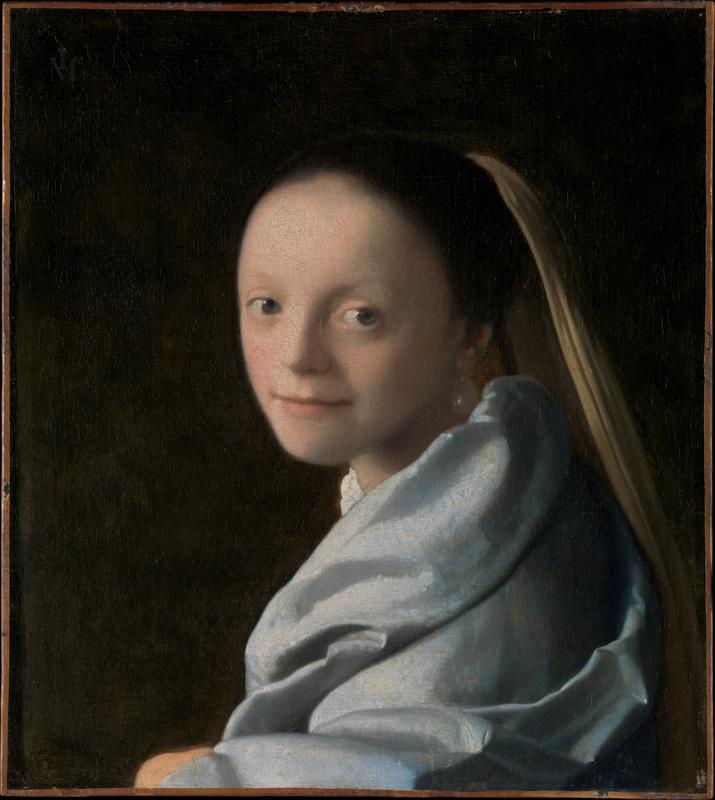More about Study of a Young Woman
- All
- Info
- Shop

Sr. Contributor
Vermeer’s (almost) done it again!
If you thought that this painting was actually the infamous Girl with a Pearl Earring, don’t worry because you’re definitely not the only one. After all, they are extremely similar. The girls pose in the same position, they’re wearing the same colors, and this girl even has an earring! Real original, Vermeer. But because this and the Mauritshuis powerhouse are the same size and were painted at about the same time, scholars believe that these works actually might have been intended to be a pair. This one-to-one conclusion makes sense when you remember where exactly these paintings come from.
Seventeenth-century Netherlandish people were a pretty literal bunch. By this time, gone were the days of Hieronymous Bosch and the awesome absurdities of the Dutch imagination. In the 1600s, these people loved the depiction of their own reality, which is incredibly boring when you think about it. This painting somehow manages to be even more dull than the one with the lady pouring a jug of milk. At least Jan Steen’s paintings of everyday people were funny! I guess Vermeer had no such sense of humor.
But I really shouldn’t rag on Vermeer too much. Save for a small group of Dutch patrons, he wasn’t very popular during his own time, and it wasn’t until the nineteenth century that scholars started recognizing him at all. It is estimated that he only painted about forty-five works during his lifetime, and we’re only aware of thirty-six of those today. With as small a body of work as this, it was pretty easy to be a Vermeer connoisseur back in the day. Pieter van Ruijven, a local collector, owned pretty much half of Vermeer’s total works, including this painting.
You best believe, though, that Vermeer wanted us to think that he had mad skills. In fact, this type of painting existed only to show off his painterly achievements. The way that Vermeer depicts the materials – the soft textiles that adorn the girl and the odd glow of her earring – paired with the figure’s soft skin tones against the darkened background are testaments to his own abilities. Although if you ask me, Vermeer made this poor girl look like she used the wrong color foundation after buffing her face with sandpaper.
New studies have revealed that Vermeer might actually just be a fraud. He was able to put all of his attention into these stunning details because he might have had the help of lenses and camera obscuras to do all the hard work for him! One scholar believes that Vermeer set up composed scenes, like women sitting with their heads turned just so and women pouring milk from jugs, and traced the projections to create outlines for his future paintings. There are still obvious merits to Vermeer’s paintings, but these new revelations really make you think about what you could do with your own paint-by-number.
Sources
- Davies, Penelope J.E., Frima Fox Hofrichter, Joseph Jacobs, Ann M. Roberts, and David L. Simon. Janson’s Basic History of Western Art. 8th edition. Upper Saddle River, NJ: Pearson Education, Inc., 2009.
- Jenkins, Simon. “Vermeer was an authentic artist genius - even if he did cheat.” The Guardian. August 10, 2017. https://www.theguardian.com/commentisfree/2017/aug/10/vermeer-artistic-…. Accessed October 25, 2017.
- Liedtke, Walter. “Catalogue Entry.” Study of a Young Woman. Collection. The Metropolitan Museum of Art. 2010. https://www.metmuseum.org/art/collection/search/437879. Accessed October 25, 2017.
- Liedtke, Walter. “Johannes Vermeer (1632-1675).” The Heilbrunn Timeline of Art History. The Metropolitan Museum of Art. October 2003. https://www.metmuseum.org/toah/hd/verm/hd_verm.htm. Accessed October 25, 2017.
Featured Content
Here is what Wikipedia says about Study of a Young Woman
Study of a Young Woman (also known as Portrait of a Young Woman or Girl with a Veil) is a painting by the Dutch artist Johannes Vermeer, completed between 1665 and 1667, and now in the Metropolitan Museum of Art, New York.
The painting was painted around the same time as the better-known Girl with a Pearl Earring and has a near-identical size. Because of this, and its proximity in tone and composition, it is sometimes considered to be either a variant or pendant painting (counterpart) of Girl with a Pearl Earring. The subjects of both paintings wear pearl earrings, have scarves draped over their shoulders, and are shown in front of a plain black background. In addition, it has been suggested (though this has also been widely contested) that the creation of both works involved the use of some optical device, such as a camera obscura or mirror, as the Hockney–Falco thesis speculates.
Check out the full Wikipedia article about Study of a Young Woman














I love a good Vermeer, and I have to say, this is not it.